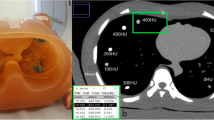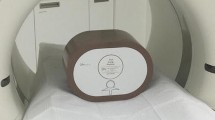Abstract
Objectives
To investigate the effect of iodine uptake on tissue/organ absorbed doses from CT exposure and its implications in CT dosimetry.
Methods
The contrast-induced CT number increase of several radiosensitive tissues was retrospectively determined in 120 CT examinations involving both non-enhanced and contrast-enhanced CT imaging. CT images of a phantom containing aqueous solutions of varying iodine concentration were obtained. Plots of the CT number increase against iodine concentration were produced. The clinically occurring iodine tissue uptake was quantified by attributing recorded CT number increase to a certain concentration of aqueous iodine solution. Clinically occurring iodine uptake was represented in mathematical anthropomorphic phantoms. Standard 120 kV CT exposures were simulated using Monte Carlo methods and resulting organ doses were derived for non-enhanced and iodine contrast-enhanced CT imaging.
Results
The mean iodine uptake range during contrast-enhanced CT imaging was found to be 0.02-0.46% w/w for the investigated tissues, while the maximum value recorded was 0.82% w/w. For the same CT exposure, iodinated tissues were found to receive higher radiation dose than non-iodinated tissues, with dose increase exceeding 100% for tissues with high iodine uptake.
Conclusions
Administration of iodinated contrast medium considerably increases radiation dose to tissues from CT exposure.
Key-points
• Radiation absorption ability of organs/tissues is considerably affected by iodine uptake
• Iodinated organ/tissues may absorb up to 100 % higher radiation dose
• Compared to non-enhanced, contrast-enhanced CT may deliver higher dose to patient tissues
• CT dosimetry of contrast-enhanced CT imaging should encounter tissue iodine uptake


Similar content being viewed by others
Abbreviations
- CTDI:
-
CT dose index
- DLP:
-
Dose length product
- NECT:
-
Non-enhanced CT
- CECT:
-
Contrast enhanced CT
- PMMA:
-
Polymethyl-methacrylate
- % w/w:
-
% weight per weight
References
Brenner DJ, Eric Hall J (2007) Computed Tomography — An Increasing Source of Radiation Exposure. N Engl J Med 357:2277–2284
Brenner DJ, Eric Hall J (2012) Cancer risks from CT scans: now we have data, what next? Radiology 265:330–331
Costello JE, Cecava ND, Tucker JE, Bau JL (2013) CT radiation dose: current controversies and dose reduction strategies. AJR Am J Roentgenol 201:1283–1290
American Association of Physicists in Medicine (AAPM) (2008) Report of AAPM Task Group 23.
Maldjian PD (2013) Reducing radiation dose in body CT: a primer on dose metrics and key CT technical parameters. AJR Am J Roentgenol 200:741–747
American Association of Physicists in Medicine (AAPM) (2014) Report of AAPM Task Group 220.
International Commission of Radiological Protection (ICRP) (2007) Managing Patient Dose in Multi-Detector Computed Tomography (MDCT). ICRP Publication 102. Ann ICRP 37 (1).
Deak P, van Straten M, Shrimpton PC, Zankl M, Kalender WA (2008) Validation of a Monte Carlo tool for patient-specific dose simulations in multi-slice computed tomography. Eur Radiol 18:759–772
Myronakis M, Perisinakis K, Tzedakis A, Gourtsoyianni S, Damilakis J (2009) Evaluation of a Patient-Specific Monte Carlo Software for CT Dosimetry. Radiat Prot Dosimetry 133:248–255
Retif P, Pinel S, Toussaint M, Frochot C et al (2015) Nanoparticles for Radiation Therapy Enhancement: the Key Parameters. Theranostics 5:1030–1044
Amato E, Lizio D, Settineri N, Di Pasquale A, Salamone I, Pandolfo I (2010) A method to evaluate the dose increase in CT with iodinated contrast medium. Med Phys 37:4249–4256
Amato E, Salamone I, Naso S, Bottari A, Gaeta M, Blandino A (2013) Can contrast media increase organ doses in CT examinations? A clinical study. AJR Am J Roentgenol 200:1288–1293
Tzedakis A, Damilakis J, Perisinakis K, Stratakis J, Gourtsoyiannis N (2005) The effect of z overscanning on patient effective dose from multidetector helical computed tomography examinations. Med Phys 32:1621–1629
Perisinakis K, Raissaki M, Theocharopoulos N, Damilakis J, Gourtsoyiannis N (2005) Reduction of eye lens radiation dose by orbital bismuth shielding in pediatric patients undergoing CT of the head: A Monte Carlo study. Med Phys 32:1024–1030
Tzedakis A, Damilakis J, Perisinakis K, Karantanas A, Karabekios S, Gourtsoyiannis N (2007) Influence of z overscanning on normalized effective doses calculated for pediatric patients undergoing multidetector CT examinations. Med Phys 34:1163–1175
Boone JM, Seibert JA (1997) An accurate method for computer-generating tungsten anode x-ray spectra from 30 to 140 kV. Med Phys 24:1661–1670
International Commission of Radiological Protection (ICRP) (2007) The 2007 Recommendations of the International Commission on Radiological Protection. ICRP Publication 103. Ann ICRP 37(2-4).
Bae KT (2010) Intravenous contrast medium administration and scan timing at CT: considerations and approaches. Radiology 256:32–61
Tremblay JE, Bedwani S, Bouchard H (2014) A theoretical comparison of tissue parameter extraction methods for dual energy computed tomography. Med Phys 41, 081905
Molina DK, DiMaio VJ (2012) Normal organ weights in men: part II-the brain, lungs, liver, spleen, and kidneys. Am J Forensic Med Pathol 33:368–372
Taylor ML, Smith RL, Dossing F, Franich RD (2012) Robust calculation of effective atomic numbers: the Auto-Z(eff) software. Med Phys 39:1769–1778
Author information
Authors and Affiliations
Corresponding author
Ethics declarations
Guarantor
The scientific guarantor of this publication is Kostas Perisinakis.
Conflict of interest
The authors of this manuscript declare no relationships with any companies, whose products or services may be related to the subject matter of the article.
Funding
The authors state that this work has not received any funding.
Statistics and biometry
One of the authors has significant statistical expertise.
No complex statistical methods were necessary for this paper.
Informed consent
Written informed consent was not required for this study because it was a retrospective study.
Ethical approval
Institutional Review Board approval was obtained.
Methodology
• retrospective
• observational
• performed at one institution
Rights and permissions
About this article
Cite this article
Perisinakis, K., Tzedakis, A., Spanakis, K. et al. The effect of iodine uptake on radiation dose absorbed by patient tissues in contrast enhanced CT imaging: Implications for CT dosimetry. Eur Radiol 28, 151–158 (2018). https://doi.org/10.1007/s00330-017-4970-1
Received:
Revised:
Accepted:
Published:
Issue Date:
DOI: https://doi.org/10.1007/s00330-017-4970-1




